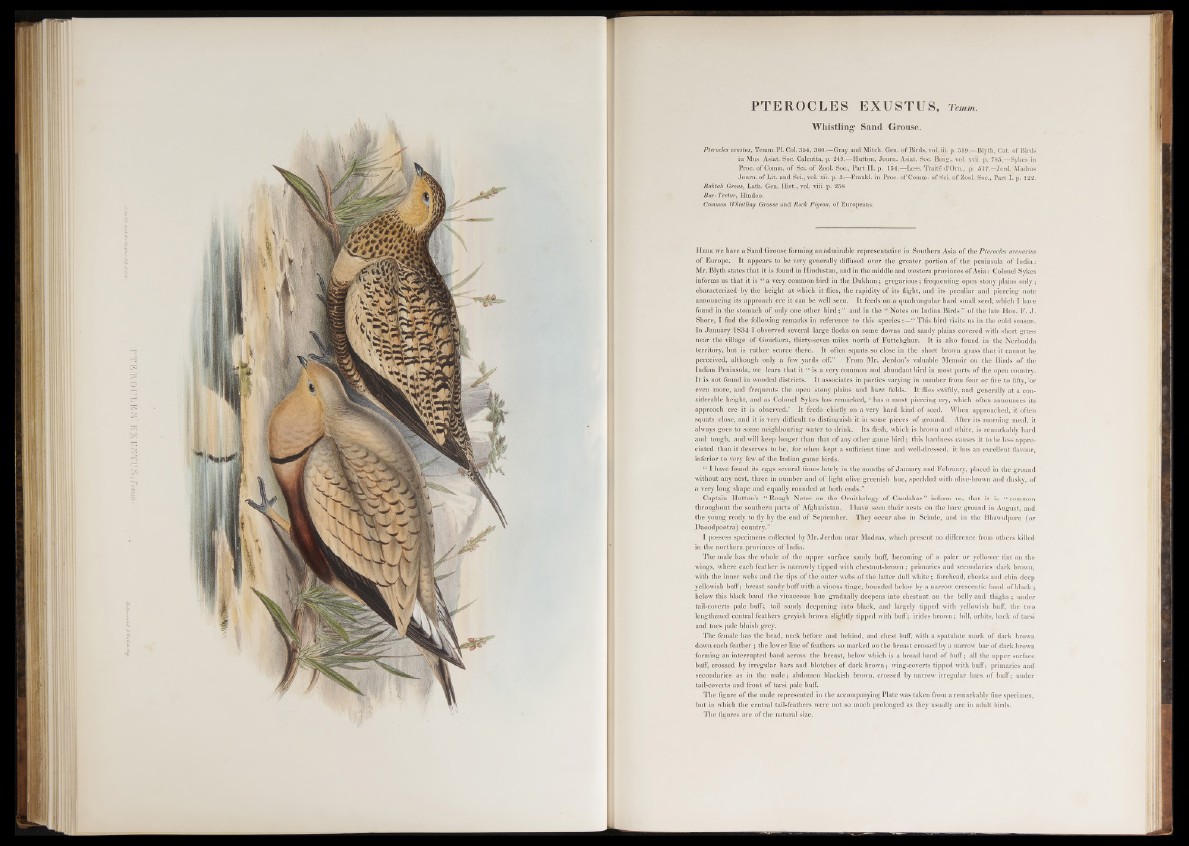
PTEROCLES EXUSTU S, Temm.
Whistling1 Sand Grouse.
Pterocles exustus, Temm. Pl. Col. 354, 360.—Gray and Mitch. Gen. o f Birds, vol. iii. p. 519.—Blyth, Cat. o f Birds
in Mus Asiat. Soc. Calcutta, p. 249.—Hutton, Joum. Asiat. Soc. Beng., vol. xvii p. 785.—Sykes in
Proc. o f Comm, o f Sei. o f Zool. Soc., Part II. p. 154.—Less. Traité d’Orn., p. 517.—Jerd. Madras
Journ. of Lit. and Sei., vol. xii. p. 3.—Frankl, in Proc. o f Comm, o f Sei. o f Zool. Soc., Part I. p. 122.
Bahtah Grous, Lath. Gen. Hist., vol. viii. p. 258.
Bur-Teetur, Hindoo.
Common Whistling Grouse and Rock Pigeon, of Europeans.
H e b e we have a Sand Grouse forming an admirable representative in Southern Asia of the Pterocles arenarius
of Europe. It appears to be very generally diffused over the greater portion of the peninsula of India:
Mr. Blyth states that it is found in Hindustan, and in the middle and western provinces of Asia: Colonel Sykes
informs us that it is “ a very common bird in the Dukhun ; gregarious; frequenting open stony plains only ;
characterized by the height at which it flies, the rapidity of its flight, and its peculiar and piercing note
announcing its approach ere it can be well seen. It feeds on a quadrangular hard small seed, which I have
found in the stomach o f only one other bird; ” and in the “ Notes on Indian Birds ” of the late Hon. F. J.
Shore, I find the following remarks in reference to this species:—“ This bird visits us in the cold season.
In January 1834 I observed several large flocks on some downs and sandy plains covered with short grass
near the village of Gourkera, thirty-seven miles north o f Futtehghur. It is also found in the Nerbudda
territory, but is rather scarce there. It often squats so close in the short brown grass that it cannot be
perceived, although only a few yards off.” From Mr. Jerdon’s valuable Memoir on the Birds of the
Indian Peninsula, we learn that it “ is a very common and abundant bird in most parts of the open country.
It is not found in wooded districts. It associates in parties varying in number from four or five to fifty, ‘or
even more, and frequents the open stony plains and bare fields. It flies swiftly, and generally at a considerable
height, and as Colonel Sykes has remarked, ‘ has a most piercing cry, which often announces its
approach ere it is observed.’ It feeds chiefly on a very hard kind of seed. When approached, it often
squats close, and it is very difficult to distinguish it in some pieces of ground. After its morning meal, it
always goes to some neighbouring water to drink. Its flesh, which is .brown and white, is remarkably hard
and tough, and will keep longer than that of any other game bird; this hardness causes it to be less appreciated
than it deserves to be, for when kept a sufficient time and well-dressed, it has an excellent flavour,
inferior to very few of the Indian game birds.
“ I have found its eggs several times lately in the months of January and February, placed in the ground
without any nest, three in number and of light olive greenish hue, speckled with olive-brown and dusky, of
a very long shape and equally rounded at both ends.”
Captain Hutton’s “ Rough Notes on the Ornithology of Candahar” inform us, that it is “ common
throughout the southern parts o f Afghanistan. I have seen their nests on the bare ground in August, and
the young ready to fly by the end of September. They occur also in Scinde, and in the Bhawulpore (or
Daoodpootra) country.”
I possess specimens collected by Mr. Jerdon near Madras, which present no difference from others killed
in the northern provinces of India.
The male has the whole of the upper surface sandy buff, becoming o f a paler or yellower tint on the
wings, where each feather is narrowly tipped with chestnut-brown; primaries and secondaries dark brown,
with the inner webs and the tips of the outer webs of the latter dull white; forehead, cheeks and chin deep
yellowish buff; breast sandy buff with a vinous tinge, bounded below by a narrow crescentic band of black ;
below this black band the vinaceous hue gradually deepens into chestnut on the belly and thighs ; under
tail-coverts pale buff; tail sandy deepening iuto black, and largely tipped with yellowish buff, the two
lengthened central feathers greyish brown slightly tipped with buff; irides brown; bill, orbits, back of tarsi
and toes pale bluish grey.
. The female has the head, neck before and behind, and chest buff, with a spatulate mark of dark brown
down each feather ; the lower line o f feathers so marked on the breast crossed by a narrow bar of dark brown
forming an interrupted band across the breast, below which is a broad band of buff; all the upper surface
buff, crossed by irregular bars and blotches o f dark brown; wing-coverts tipped with buff; primaries and
secondaries as in the male; abdomen blackish brown, crossed by narrow irregular bars of buff; under
tail-coverts and front of tarsi pale buff.
The figure of the male represented in the accompanying Plate was taken from a remarkably fine specimen,
but in which the central tail-feathers were not so much prolonged as they usually are in adult birds.
The figures are of the natural size.